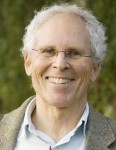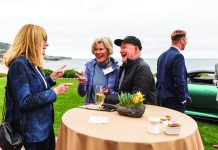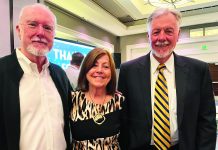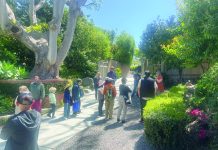Saving Oceans, One Film at a Time

I’ve heard Greg MacGillivray speak many times. He spoke at our son Brooks’ graduation from Laguna Beach High School back when I could still get up on a surfboard. He has spoken at other venues in town and continues to speak before large, appreciative, mainly hometown audiences at special presentations of his many films at the Irvine Spectrum theater. His message has been consistent: the ocean is our lifeline, our joy, care for it. It seems to be at the heart of his family’s One World One Ocean initiative aimed at promoting marine protected areas and harvesting the ocean’s resources sustainably.
That said, never before have I heard him speak with the urgency and passion that my wife and I and others witnessed when he spoke on conservation at the Laguna Canyon Conservancy this past Monday, March 6. Our city’s trees need saving; our coastline’s Blue Belt likewise. In terms of the larger picture, ocean acidification tied to climate change and pollution were mentioned as problems that demanded the public’s immediate attention and that of governments at all levels. MacGillivray registered that these long-standing threats to ocean health have recently been compounded by the new administration in Washington, D.C. The citizenry, he emphasized, would play the key role in conservation by activism and environmentally conscious lifestyles. He quoted marine biologist Dr. Sylvia Earle: “Our actions over the next 10 years will determine the state of the ocean for the next 10,000 years.”
While this was the substance of what MacGillivray said to the packed house at the Conservancy dinner, of only slightly less importance was the way he said it—by storytelling. The story, illustrated by slides and film clips, was at once far ranging and personal, local and global, and always engaging. What Ken Burns brings to life for history lovers, Greg MacGillivray does for an even broader audience of all ages and circumstances by situating viewers in largely remote places few can or will ever visit. Among others, these venues include South Pacific atolls, Arctic ice floes, the Colorado River, the tops of giant redwood trees, aeries on the Channel Islands, Everest. Embedded in these IMAX award-winning productions are the stories of people, their diverse cultures, and how they try to live sustainably in accordance with the bounties and limitations of their respective environments.
That this mode of storytelling works is proven by the fact that MacGillivray Freeman Films (the name of his family’s company) have been highly successful commercially, have won critical acclaim with two Academy Award nominations, and have been shown at Science Center IMAX theaters and other similar venues worldwide. Millions upon millions of viewers, of all ages, have been reached. Having taught for decades at Santa Ana College, I regularly showed “Adventures in Wild California” to students in my California history courses. How else within the space of 42 minutes could students learn so much about the largest living life forms on the planet (giant sequoias), the repopulation of a once nearly extinct bird species (bald eagles), and the unbounded creativity (Walt Disney) baked into the DNA of so many Californians?
But why does such cinematic storytelling work? I think it works because it hits viewers at different levels of cognition. Our visual senses are aroused by the beauty of a bayou or South Pacific seascape, the grandeur of a Southwestern landscape, or the aesthetic-spiritual draw of a Buddhist monastery perched high in the Himalayas, and invariably by the incomparable IMAX screen. Having gotten our attention, storyteller MacGillivray sprinkles in doses of science and cultural history. All of this is presented with an even-handedness and style that transcends partisan politics and the ever-raging culture wars between liberals and conservatives. Perhaps it works because this filmmaker is at bottom an artist who seems to understand intuitively what Dostoevsky said long ago: “Beauty will save the world.”
Tom Osborne has written “Pacific Eldorado: A History of Greater California” (2013), and the University of California Press will release in November his most recent book, “Coastal Sage: Peter Douglas and the Fight to Save California’s Shore.”




